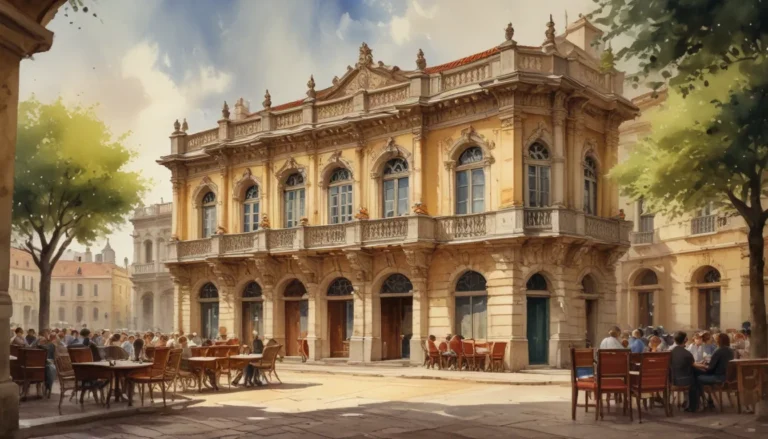The images in our articles are for illustrative purposes only and may not exactly match the content. They are intended to capture your interest and complement the text, not to replace it.
Landmarks are not just ordinary structures; they represent history, culture, and human accomplishment. From the famous Eiffel Tower to the mystical Great Wall of China, these iconic landmarks have captured the hearts and minds of people worldwide. But beyond their beauty lies a world of intriguing stories and unique features that are often overlooked.
In this article, we will explore the captivating world of landmarks and uncover 10 uncanny facts that will ignite your curiosity and leave you in awe. Prepare to embark on a journey filled with astonishing revelations and remarkable insights about some of the most renowned landmarks around the globe. Let’s unravel the mysteries surrounding these extraordinary structures and uncover the hidden treasures that make them truly exceptional.
Key Insights:
- The Eiffel Tower was originally intended for Barcelona but found its home in Paris, becoming a symbol of love and romance.
- The Great Wall of China, though impressive, is not visible from space, contrary to popular belief.
The Captivating Eiffel Tower:
Gustave Eiffel, the visionary behind the iconic Eiffel Tower, initially proposed the structure to be built in Barcelona, Spain. However, the city rejected the design, leading to the tower finding its place in Paris, where it has become a global symbol of love and romance.
The Enigmatic Great Wall of China:
Contrary to popular belief, the Great Wall of China is not visible from space with the naked eye. This misconception, often cited as fact, has been debunked by astronauts and experts. While the wall is unquestionably impressive, it is not discernible from the vast expanse of space.
The Symbolic Statue of Liberty:
The Statue of Liberty, an emblem of freedom and democracy, was a gift from the people of France to the United States. Designed by Frédéric Auguste Bartholdi, this monumental sculpture was dedicated in 1886 and has since welcomed numerous immigrants to America’s shores.
The Colosseum’s Spectacular Shows:
The Colosseum in Rome, an architectural marvel of ancient times, hosted gladiator contests, animal hunts, and dramatic performances. With a capacity for up to 80,000 spectators, this grand amphitheater serves as a testament to Roman engineering ingenuity.
The Transformative Taj Mahal:
Due to its white marble construction, the Taj Mahal undergoes a color transformation throughout the day. From a soft pink hue at dawn to a radiant white under the midday sun and a golden glow at dusk, this architectural wonder never fails to enchant onlookers.
The Sydney Opera House’s Epic Journey:
The Sydney Opera House, renowned for its sail-like design, took 16 years to complete. Despite facing numerous challenges, including complex engineering and budgetary constraints, this iconic performing arts venue stands as a testament to human creativity and perseverance.
The Magnificent Christ the Redeemer:
The Christ the Redeemer statue in Rio de Janeiro, overlooking the vibrant city, is made of soapstone, a durable and weather-resistant material. This iconic monument has come to embody the beauty and spirit of Brazil.
The Towering Mount Everest:
Mount Everest, standing at an awe-inspiring 29,032 feet (8,849 meters), is the world’s highest peak above sea level. Its formidable presence continues to attract adventurers and mountaineers from across the globe.
The Timeless Pyramids of Giza:
The Pyramids of Giza, the oldest of the Seven Wonders of the Ancient World, are the sole survivors of the original list. These ancient structures, constructed as elaborate tombs for pharaohs, continue to captivate visitors with their timeless grandeur.
Conclusion:
Landmarks are not mere structures; they embody human achievement, cultural significance, and historical legacy. From ancient wonders to modern marvels, each landmark tells a unique story that captivates the imagination and leaves a lasting impact. These iconic structures stand as testaments to human ingenuity, creativity, and perseverance, inviting us to marvel at their grandeur and ponder the enduring legacy they represent.
FAQs:
-
What makes a landmark significant?
Landmarks are deemed significant for their historical, cultural, architectural, or natural importance. They often symbolize human achievement, mark historical events, or showcase exceptional architectural prowess, making them revered and renowned. -
How are landmarks preserved for future generations?
Preservation efforts for landmarks involve maintenance, restoration, and conservation practices. These efforts aim to safeguard the structural integrity, historical significance, and cultural value of landmarks for future generations to appreciate and cherish.
By exploring these extraordinary landmarks, we gain a deeper appreciation for the rich tapestry of human civilization and the remarkable feats that have shaped our world. Join us on this fascinating journey of discovery and marvel at the wonders that continue to inspire awe and admiration.






